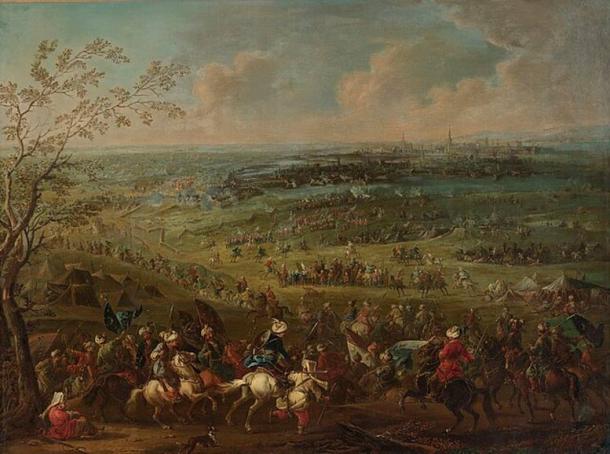🔴 Website 👉 https://u-s-news.com/
Telegram 👉 https://t.me/usnewscom_channel
Europe has seen a lot of bloody battles throughout its history, but few have been as pivotal as 1683’s Battle of Vienna. This bloody confrontation between the Ottoman Empire as the aggressors and a coalition of European forces not only halted the Ottomans’ westward expansion but also marked the beginning of their gradual retreat from the continent. Taking place amidst the grandeur and strategic importance of Vienna, this battle brought together multiple armies and displayed the determination of Europe’s rulers to defend their lands and faith. In one of history’s great underdog stories, just as the Ottomans seemed sure to win, Europe snagged victory from the jaws of defeat.
Defending Europe – The Battle of Vienna
The 17th century was a scary time for mainland Europeans, one of conflict and massive territorial ambition across Europe. The cause of this strife was the Ottoman Empire, a formidable force since the 14th century that had spent the last three centuries greedily gobbling up the Balkans and parts of Central Europe.
By 1683, the unrelenting Ottomans had set their sights on wealthy Vienna, the capital of the Habsburg Monarchy. The city was a prize too good to pass up for the Ottomans. Not just a strategic military target; Vienna was a symbolic prize, representing the heart of Christian Europe. The Ottomans couldn’t resist.
The Ottomans before the walls of Vienna, by August Querfurt. (Public Domain)
Under the command of Grand Vizier Kara Mustafa Pasha, the Ottomans and their army thought that capturing Vienna would lead to further expansion into Western Europe. They had already done the same in Hungary and the Balkans and the Ottomans were rightly feeling emboldened. Even better, the Habsburg Monarchy, led by Emperor Leopold I, was feeling the pressure. The empire had stretched itself thin dealing with both internal strife and conflicts on multiple fronts.
Aware enough to see he was under threat, Emperor Leopold I called upon the Holy League (a group of friendly Christian states formed for the express purpose of resisting the Ottomans) for help. The alliance included heavy hitters like the Polish-Lithuanian Commonwealth, several powerful German states, and a handful of other local powers. The most intimidating figure in this coalition was easily King John III Sobieski of Poland. A seasoned military leader, he was known for his tactical acumen and resolve. Vienna needed his help.
A bronze coin minted to commemorate the formation of the Holy League (Martin Brunner/CC BY-SA 4.0)
The Ottomans may have been feeling confident, but unbeknownst to them, as they prepared for an epic siege, their target was making sure it wouldn’t go down without a fight. Not just Vienna was on the line, but the whole of Europe too. All Vienna needed to do was holdout until backup arrived.
The Ottomans Lay Siege
The Ottoman Siege of Vienna got underway on July 14, 1693, when around 150,000 Ottoman troops encircled the city. Grand Vizier Kara Mustafa Pasha aimed to starve the city into submission by cutting off supply lines and wearing down the city’s defenses with constant attacks. The defenders, approximately 15,000 strong, were led by Count Ernst Rüdiger von Starhemberg, a seasoned commander determined to hold the city against overwhelming odds.
The defenders were severely outnumbered and faced harsh conditions. Food and other supplies soon began to run out, and disease quickly began to run rampant. Despite these hardships, the city’s fortifications, including bastions and defensive walls, proved resilient against Ottoman artillery and mining operations. Knowing that sometimes the best defense was a good offense, Starhemberg and his men mounted a tenacious defense, repelling multiple assaults and conducting sorties to disrupt Ottoman operations.
Despite these successes, morale within the city began to fail as weeks turned into months. Starvation and the constant threat of death by bombardment took their toll on the civilian population, who looked anxiously to the horizon for the promised relief forces. Starhemberg, well aware that a mutiny would spell the end, maintained strict discipline among his troops and organized a robust defense strategy, utilizing the city’s architectural strengths and the determination of its inhabitants.
The siege was no cakewalk for the Ottomans, either. They had expected an easier victory, and the Vizier’s solution was to keep throwing bodies at the problem. It was a costly strategy, and over the course of the siege, the Ottomans lost nearly 50,000 men to the defenders. It’s also estimated that up to 25% of the Ottoman army simply deserted, tired of the terrible conditions and poor leadership.
Meanwhile, outside Vienna, the Holy League’s forces were gathering. The coalition army, led by King John III Sobieski of Poland, coordinated its movements to relieve the besieged city. Understanding the strategic importance of timing, Sobieski aimed to strike just as the Ottomans were about to breach Vienna’s defenses. The fate of the city—and perhaps all of Europe—hung in the balance as the decisive moment approached.
King John III Sobieski blessing Polish attack on Turks in Vienna 1683. (Public Domain)
The Battle
Things reached a head on September 6, 1683, when the Holy League’s relief forces finally made an appearance. Numbering around 70,000 men, led by King John III Sobieski of Poland, the coalition was made up of soldiers from the Holy Roman Empire, the Polish-Lithuanian Commonwealth, Bavaria, Saxony, and other German states. Sobieski, known for his strategic brilliance, took command of the coalition and planned the attack for maximum effect against the already strained Ottoman forces.
The relief army’s assault began on September 12. Sobieski split his forces into three groups and launched a coordinated attack on multiple fronts. The largest contingent, composed of Polish and German infantry, advanced through the Vienna Woods to strike the Ottoman flanks. Meanwhile, Sobieski’s elite Polish Winged Hussars prepared for a decisive cavalry charge.
Kara Mustafa Pasha, confident in his siege operations, was taken by surprise by the speed and intensity of the coalition’s attack. The Ottomans, positioned around their siege lines and entrenchments, scrambled to defend against the multi-pronged assault. The battle quickly escalated into a chaotic and brutal confrontation that the Ottomans weren’t prepared for.
Husaria’s Attack – Winged Hussars, painting by Orłowski. (Public Domain)
The turning point came in the afternoon when Sobieski led the famed Winged Hussars in a dramatic downhill charge. The sight of these heavily armored, wing-adorned cavalrymen thundering towards them shattered Ottoman morale. The hussars broke through the Ottoman lines, causing panic and disarray among the besieging forces. This decisive cavalry charge, combined with relentless infantry pressure, overwhelmed the Ottomans.
As the dust settled, the Ottoman army was in full retreat. Kara Mustafa Pasha’s forces abandoned their siege equipment and supplies as they fled, marking a catastrophic defeat. The coalition’s timely and well-coordinated attack had not only lifted the siege but also inflicted significant losses on the Ottoman army, ending their campaign against Vienna.
In The Aftermath
The Holy League’s forces entered Vienna to a hero’s welcome. Vienna and Europe had been saved, and the Ottomans were given more than a bloody nose in the process. For the Holy League, it was a major morale boost, especially for King John III Sobieski, who was hailed as the “Savior of Vienna” and celebrated across Europe. Talk about being the man of the hour. The alliance between the Habsburg Monarchy, Poland-Lithuania, and other German states was also strengthened, leading to more coordinated military efforts against the Ottomans in the subsequent years.
Plaque of John III Sobieski at the Polish Congregatio Resurrectionis church on Kahlenberg (Pitert / Piotr Tysarczyk/CC BY-SA 1.0)
For the Ottomans, it was nothing short of a disaster. Grand Vizier Kara Mustafa Pasha was deemed responsible for the failure, a mistake for which the Sultan took his head. Killing the Vizier did the Sultan little good, however. The loss at Vienna led to a stalling of Ottoman territorial expansion into Europe that never started up again. Over the next few decades, the Ottoman Empire would face a series of military defeats, losing territory and influence in the region.
Imaginative portrait of Grand Vizier Kara Mustafa Pasha. (Public Domain)
The Habsburg Monarchy, feeling buoyed, used the victory to lead a counter-offensive against their enemy. This led to the Great Turkish War, during which the Habsburgs, supported by the Holy League, gradually reclaimed large parts of Hungary and the Balkans that had been under Ottoman control. This shift in territorial control marked the beginning of the decline of Ottoman dominance in Southeast Europe.
The battle also had a significant impact on European military tactics and fortification strategies. The successful defense of Vienna highlighted the importance of strong, well-coordinated alliances and the effective use of cavalry in battle, lessons that would influence European warfare for years to come.
Conclusion
The Battle of Vienna in 1683 was a watershed moment in European history. It’s safe to say that if the battle had gone a different way, the European landscape today would be very different.
The battle marked the end of Ottoman expansion into Europe and the beginning of their decline. The events that had transpired proved that with the right strategic alliances and with good leadership, even the most powerful enemies could be felled. The Ottomans learned the hard way that Europe was not up for grabs.
The victory at Vienna had lasting impacts on the political and cultural landscape of Europe, influencing the course of history for centuries to come. It began a monumental shift in the balance of power and showed the benefits of working together. Of course, this being human history, it wouldn’t take all that long for the European powers to forget that particular lesson.
Top image: Battle of Vienna 1683. Source: Public Domain






